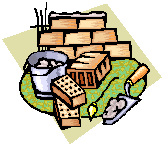Submerged Arc Welding
call us today
- 1-800-567-1362
How is HARDFACING a part of my everyday life?
by
Robert F. Miller
I know what you’re probably thinking, ….”A part of my life??? I hope not, it sounds like some kind of debilitating facial disease associated with hardening of the arteries.” Relax, Hardfacing is an industrial process used to prolong equipment life. It has nothing to do with the your bodily attributes. But it does affect practically everything you touch, see, taste, feel and consume. It is very much associated with WEAR.
Wear is just not associated with tires, clothes, cars, TV’s and lawn mowers. It happens to everything, sooner or later and sometimes faster than we care to think about. Practically everything we come in contact with is associated with some type of wear. But before we get into the meat of the subject, let’s take a look at what Webster has to say about WEAR:
- To cause to deteriorate by use.
- To impair or diminish by use or attrition.
- Consume or waste gradually.
- To produce gradually by friction or attrition.
- To exhaust or lessen the strength of.
Industry defines it in more technical terms:
| Abrasion | Friction |
| Corrosion | Erosion |
| Fretting | Fatigue |
I have estimated that industry spends over $2.2 Billion annually because of wear. As a member of Management, I’m sure you’re concerned about how this all affects your bottom line. Your particular industry may employ a number of methods to combat wear, such as painting, lubricating, plating, and galvanizing, just to mention a few. Your industry may in fact employ a growing technology known as Hardfacing, hardsurfacing, or cladding. If not, then I think you will find the following most interesting.
What is Hardfacing? Well, quite simply, Hardfacing is an industrial welding or overlay process that is applied to material handling components to resist wear and prolong working life. Not only is this technique cost effective, it is highly versatile as well. Simply by changing the Hardfacing alloy, a component can exhibit as much as 30 times its intended life. I don’t mean to imply that all Hardfacing components exhibit this type of dramatic result, but the technology, applied properly, can produce some very satisfying returns. .
In the same way that wear touches practically every aspect of our lives, so too does Hardfacing. That may seem a little far fetched, but I assure you it is true. Just to see how extensive this process is, let’s take a simple task like running an errand to the grocery store and examine just where Hardfacing plays a role.
As you start for the door, you are asked to take out the trash. On the way you switch out the light as you go. Let’s stop right here to examine how we benefit by Hardfacing:
![]() Light Switch: Made of plastic Plastics or polymers are extruded under very high pressures into molds. The extrusion press resembles a screw auger and it experiences excessive wear. Polymers are abrasive in nature. The flights and barrel of the screw auger are systematically hardfaced with Nickel or Cobalt Hardfacing to extend their life..
Light Switch: Made of plastic Plastics or polymers are extruded under very high pressures into molds. The extrusion press resembles a screw auger and it experiences excessive wear. Polymers are abrasive in nature. The flights and barrel of the screw auger are systematically hardfaced with Nickel or Cobalt Hardfacing to extend their life..
 Brass Door Knob: Brass is an alloy of Copper. Copper mines, as well as other mines, throughout the world require Hardfacing of ground engaging equipment such as buckets, truck bed liners, and dozer blades. Smelting is a process related to the production of copper alloys. Many smelting operations require the Hardfacing of various components that wear because of excessive heat. The dies used in the forming of the door knob are typically hardfaced with tool steels to prevent excessive wear.
Brass Door Knob: Brass is an alloy of Copper. Copper mines, as well as other mines, throughout the world require Hardfacing of ground engaging equipment such as buckets, truck bed liners, and dozer blades. Smelting is a process related to the production of copper alloys. Many smelting operations require the Hardfacing of various components that wear because of excessive heat. The dies used in the forming of the door knob are typically hardfaced with tool steels to prevent excessive wear.
Wooden Door: The harvesting of trees has a number of areas where Hardfacing plays a major role. Bark is very abrasive because of imbedded sand, etc.. Debarking equipment requires constant upkeep with Hardfacing products. Further processing of the wood, particularly if the door is a pressed composite, involves a number of processing operations that are prone to wear by wood chips and corrosive processing liquids. Hardfacing products are applied on a routine basis to extend component life.
 Light Bulb: The lightbulb is powered by electricity which in turn is generated by perhaps a fossil fuel such as Coal. Coal is abrasive because of varying amounts of silica or sand found within the ore. Coal crushing equipment wears out very quickly as a result of this abrasive nature of coal. Hardfacing has a long and successful history in equipment restoration. If power is supplied by water as in hydro stations, large turbines are a constant source of wear by erosion. Stainless steels and Nickel alloys are used as a cladding on the turbine blades and other components.
Light Bulb: The lightbulb is powered by electricity which in turn is generated by perhaps a fossil fuel such as Coal. Coal is abrasive because of varying amounts of silica or sand found within the ore. Coal crushing equipment wears out very quickly as a result of this abrasive nature of coal. Hardfacing has a long and successful history in equipment restoration. If power is supplied by water as in hydro stations, large turbines are a constant source of wear by erosion. Stainless steels and Nickel alloys are used as a cladding on the turbine blades and other components.
 As you step onto the brick sidewalk and walk to the car, you are walking on a product whose manufacturing equipment constantly requires attention by Hardfacing products. Every component of the brick is highly abrasive.
As you step onto the brick sidewalk and walk to the car, you are walking on a product whose manufacturing equipment constantly requires attention by Hardfacing products. Every component of the brick is highly abrasive.
You toss the garbage into the trash can. Trash compaction, burning, and handling are highly wear prone processes. Excessive heat, abrasion and corrosion, related to turning waste into energy require some of the most sophisticated wear materials that Hardfacing technology can offer.
 You open the door to your car. Every component of the vehicle is linked in some way to Hardfacing; from mining the ore to produce the steel, to the actual steel-making process itself, to the forming and the casting of parts and components. Even the glass windows are related to Hardfacing. Much of the glass comes from recycling. Ground glass is very abrasive.
You open the door to your car. Every component of the vehicle is linked in some way to Hardfacing; from mining the ore to produce the steel, to the actual steel-making process itself, to the forming and the casting of parts and components. Even the glass windows are related to Hardfacing. Much of the glass comes from recycling. Ground glass is very abrasive.
Once your car has seen its useful life, it will no doubt head for the scrap pile. The car is shredded and recycled. The shredder, through excessive pounding and gouging, experiences excessive wear from abrasion and impact. Only Hardfacing products can effectively extend the life of the shredders’ hammers.
 As you drive down the street, the Asphalt road was paved by equipment that employs many hardfaced components. Asphalt is spread onto the street by screw augers which are prone to excessive wear by hot abrasion. Back at the plant, mixing paddles, hoppers and material handling equipment is extended by Hardfacing.
As you drive down the street, the Asphalt road was paved by equipment that employs many hardfaced components. Asphalt is spread onto the street by screw augers which are prone to excessive wear by hot abrasion. Back at the plant, mixing paddles, hoppers and material handling equipment is extended by Hardfacing.
 As you arrive at the grocery store, again you are bombarded with products that are related in many ways to Hardfacing. The concrete buildings, that the produce is housed in, are closely related to Hardfacing. Both the concrete and cement industries are primary consumers of many Hardfacing products. Portland cement for example, is a mixture of sand and clay that is heated in a kiln to very high temperatures. The resulting “Clinker” is highly abrasive, and is further pulverized. Practically every piece of equipment used in this process is routinely hardfaced, including all the equipment used to produce the heat for the high temperature kiln.
As you arrive at the grocery store, again you are bombarded with products that are related in many ways to Hardfacing. The concrete buildings, that the produce is housed in, are closely related to Hardfacing. Both the concrete and cement industries are primary consumers of many Hardfacing products. Portland cement for example, is a mixture of sand and clay that is heated in a kiln to very high temperatures. The resulting “Clinker” is highly abrasive, and is further pulverized. Practically every piece of equipment used in this process is routinely hardfaced, including all the equipment used to produce the heat for the high temperature kiln.
 Once inside the grocery store, you are surrounded by a multitude of products that depend upon Hardfacing. Vegetables are harvested by ground engaging equipment, and most likely come from the Great Central Valley in California. The soil in this valley is some of the most abrasive in the world. Many of the Hardfacing products developed today are a result of trying to cope with the massive wear of components in the Agricultural field.
Once inside the grocery store, you are surrounded by a multitude of products that depend upon Hardfacing. Vegetables are harvested by ground engaging equipment, and most likely come from the Great Central Valley in California. The soil in this valley is some of the most abrasive in the world. Many of the Hardfacing products developed today are a result of trying to cope with the massive wear of components in the Agricultural field.
Cartons and boxes are other Hardfacing related products. The production of these products stems back to the Pulp and Paper industry. Paper is made from wood chips that are reduced to fibers, known as pulp. Wood chips are processed at high speeds and will wear steel plates out in short order. Pulp and Paper mills are chemical plants, and corrosion plays havoc with many material handling components. Hardfacing and protective overlays of stainless alloys are employed to increase equipment life.
I could go on, but I think you’re getting the idea. Hardfacing applications abound in many industries. The table below mentions a few:
|
|
You might be wondering why the computer industry is not mentioned. Well, just think about what the computers are manufactured from; polymers, glass, and copper products. I think those were covered above.
The Hardfacing industry has made great advances both in alloy and process development. Automation is replacing many of the labor intensive methods of manual arc welding. Lasers, electron beams and ultrasonics are emerging as viable alternative Hardfacing processes. New alloys are continually being developed to combat corrosion, erosion and abrasion. Cobalt and Nickel base materials are becoming more widely used in applications involving heat and frictional wear. Iron base alloys are continually being upgraded to meet the demand for more wear resistance.
As materials are being developed, so are the techniques to measure wear resistance. Thirty years ago, very few reliable tests were available to actually measure wear. Now, many manufacturers and vendors, routinely employ standard wear tests, such as the ASTM G-65 as part of their Quality Assurance programs. These standard test results are also becoming an integral part of Original Equipment specifications.
We live in an age of great consumption, particularly in the West. As we progress into the next century, the World will make even greater demands upon raw materials and consumer products. Hardfacing has not only met the demands of the current century, it will no doubt rise to the challenge of the next century.
You may not have even heard of the word “Hardfacing” before reading this article. Let’s face it, it’s not a household word and not even a popular industrial word, but it lives with us daily. It is responsible for bringing us many of the products and services we enjoy today. Perhaps, knowing just how invasive this technology is in everyday industrial settings, a new appreciation will be realized for its vast contribution and potential in a war against wear.
It has been said, (author unknown) that a dollar saved in Production is equitable to a 10 times increase in Sales and a 20 times increase in Profits. The numbers may be a little off, depending upon the industry, etc., but the concept is sound. Hardfacing can play a major role in your bottom line and become your household or industrial “Word”.
Reprinted Articles courtesy of cladtechnologies.com
Practical Welding Today®
Submerged arc welding : then and now
It’s not your father’s sub-arc process
By Steven Rainwater, Contributing Writer
July 29, 2008
Increased demands in shipbuilding paired with more infrastructure projects have driven technology advancements in submerged arc welding.
Full article here
Reprinted Articles courtesy of cladtechnologies.com & fabricator.com
Cladded Wear Plates in Mining Applications
Hardfacing in your everyday life
We Manufacture:
All of our welding tips are made from the highest quality ISO Extruded Tubing.
Schedule Your FREE Trial
in North America
Superior Consumables product is backed by proven, documented test results.
For All Your Mig Welding Needs!
